




Respiration in Plants NEET Notes, Important Questions and Summary
This document on Respiration in Plants is specially designed for the students who are in search of concise content as per the NEET point of view. It carries all the important topics of the chapter along with the solved sample questions and practice questions, added at the end of the article.
Topics such as how do plants respire, what all are the processes included, Glycolysis and its steps, aerobic and anaerobic respiration and other important information have been added in this piece article. So, by going through the article, the student can revise the chapter in one go.
Important Topics of Respiration in Plants
Glycolysis
Fermentation
Aerobic Respiration
Electron Transport System (ETS)
Oxidative Phosphorylation
Krebs Cycle
Amphibolic Pathway
Respiratory Quotient
Important Concepts of the Chapter
Plants, just like most species on the planet, need oxygen to survive, and as a result, they breathe. Plants, on the other hand, do not have organs specialised in the process of gaseous exchange, therefore they do not breathe like most mammals. Instead, they use stomata and lenticels, which are organelles that let them breathe.
The oxidative breakdown of food materials within the cell to liberate energy and the storage of this energy for the production of ATP is referred to as cellular respiration.
How Do Plants Respire?
Plants undergo the process of photosynthesis to make sugars (such as glucose), which are combined with oxygen to produce energy for the plant's growth. The process of respiration is similar to that of photosynthesis, however, it occurs in the opposite direction.
Glycolysis
The EMP pathway is a term used to describe the glycolysis system. In anaerobic species, glycolysis is the only method of respiration. This is a mechanism in which glucose is partially oxidised and two molecules of pyruvic acid are formed in the cytoplasm of the cell and are found in all living things.
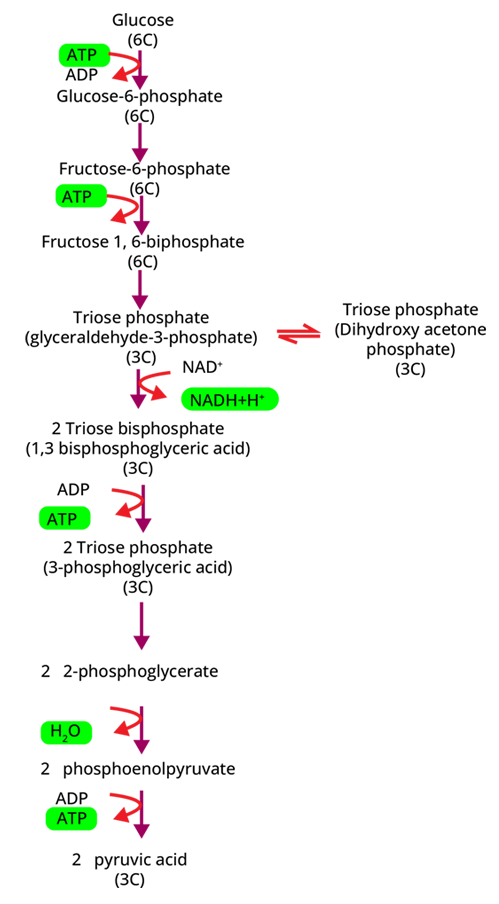
Fermentation
In this mechanism, under anaerobic conditions, incomplete oxidation of glucose is achieved through a series of processes that culminate in the conversion of carbon dioxide to ethanol, reactions catalysed by enzymes such as alcohol dehydrogenase and pyruvic acid decarboxylase.
The below-given diagram represents the steps involved in fermentation:
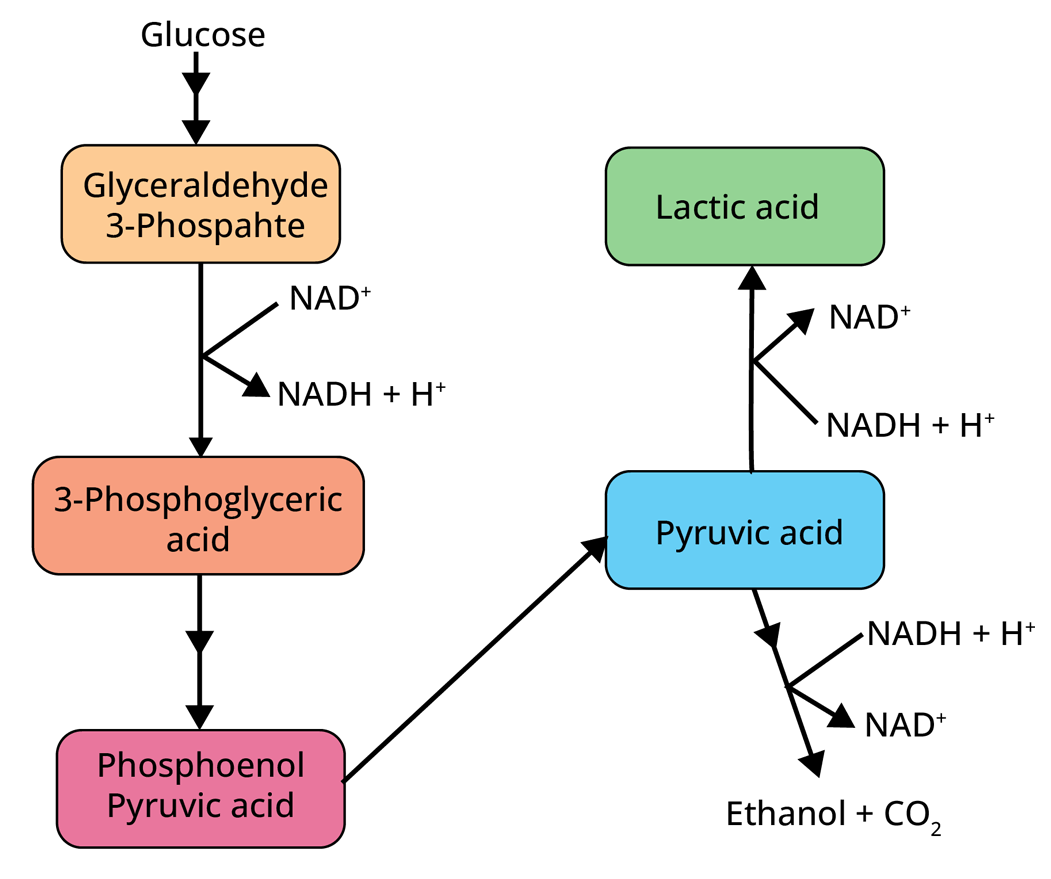
Aerobic Respiration
The complete oxidation of organic compounds in the presence of oxygen occurs in this process, releasing water, carbon dioxide, and a tremendous quantity of energy from the substrate. Higher creatures are the ones who use aerobic respiration the most. Pyruvate is transferred from the cytoplasm into the mitochondria in order for it to happen inside the mitochondria, the final product of glycolysis.
The following are some significant events that are taking place:

Complete pyruvate oxidation, leaving 3 molecules of
Transferring electrons lost as part of hydrogen atoms to molecular oxygen, while simultaneously synthesising ATP.
Tricarboxylic Acid Cycle/Krebs Cycle
The Tricarboxylic Acid (TCA) Cycle, also known as the Krebs Cycle, and the Electron Transport System play a pivotal role in aerobic respiration.
The TCA cycle is a series of chemical reactions that occur in the mitochondria, where acetyl-CoA is oxidized to release carbon dioxide and generate NADH and FADH2. These high-energy molecules then fuel the Electron Transport System.
The Electron Transport System is a chain of protein complexes in the inner mitochondrial membrane. It harnesses the energy from NADH and FADH2, generating a proton gradient. This gradient drives ATP synthesis through chemiosmotic coupling, resulting in the production of a maximum of 34 ATP molecules in aerobic respiration. Understanding this process is crucial in comprehending how plants extract energy from organic molecules.
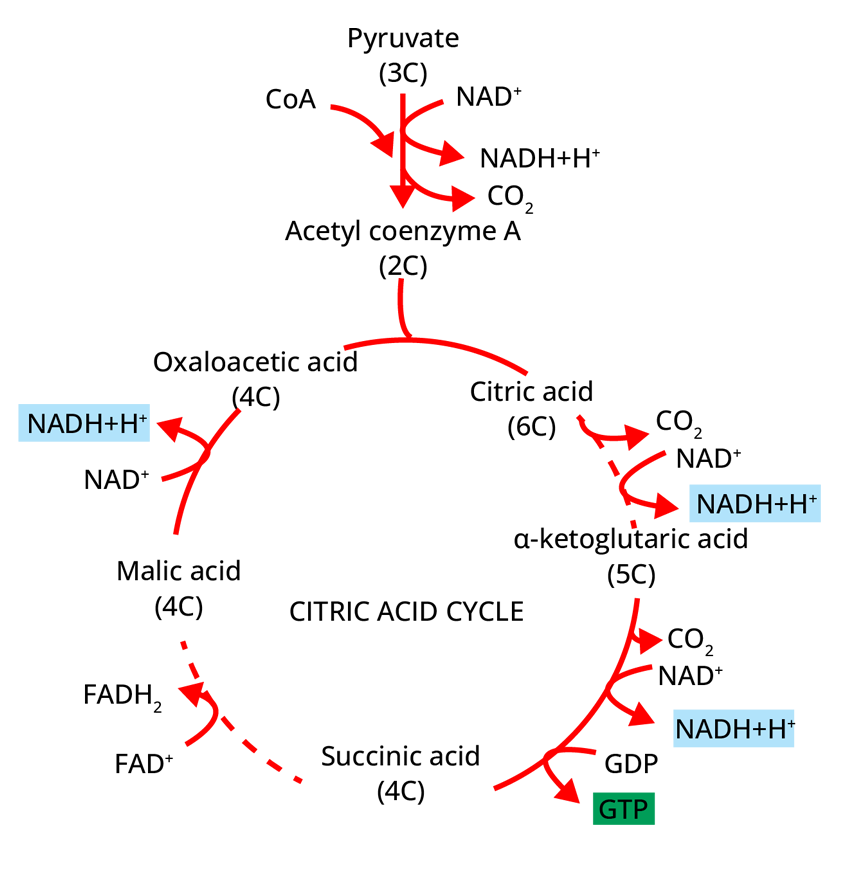
The summary equation for this phase of respiration may be written as follows:

Electron Transport System (ETS) and Oxidative Phosphorylation
Cellular respiration ends with the electron transport chain, which is the most critical phase. While Glycolysis and the Citric Acid Cycle provide the essential precursors, the electron transport chain is responsible for the majority of ATP production. Both photosynthesis and cellular respiration rely heavily on it.
It is the metabolic process by which electrons travel from one carrier to another and is found in the inner mitochondrial membrane.
More information can be found in the diagram below.
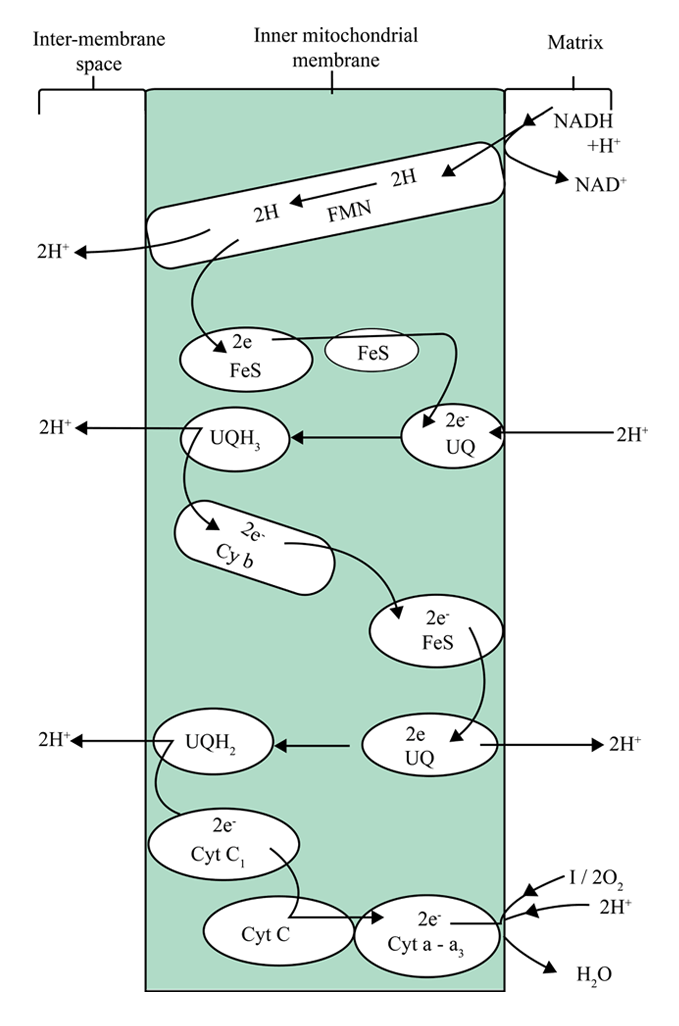
Below Given Table Represents The Differences Between Oxidative Phosphorylation and Phosphorylation.
Comparison Between Aerobic Respiration and Fermentation
Amphibolic Pathway
For respiration, glucose is the preferred substrate. Before being used for respiration, all carbs are normally transformed into glucose.
Fats must first be broken down into glycerol and fatty acid, which must then be transformed into Acetyl CoA before entering the respiratory system.
Proteins are broken down into amino acids, which then go through the Krebs cycle.
Catabolism is the breakdown process within a living thing, while anabolism is the synthesis process. As a result, respiration is an Amphibolic process.
Respiratory Quotient
The Respiratory Quotient (RQ) is defined as the ratio of carbon dioxide emitted to oxygen consumed during breathing. The respiratory ratio is another name for it. The type of respiratory substrate used during respiration affects this ratio. When carbohydrates are used as substrates and totally oxidised, the RQ is 1. This is because carbon dioxide and oxygen are both produced and consumed in equal amounts.
Solved Examples from the Chapter
1. The cofactor required for the activity of pyruvate dehydrogenase is
Zinc
Magnesium
Manganese
Copper
Ans: b. Magnesium
Key point to remember:

2. In the absence of oxygen, the primary purpose of fermentation is to
Produce amino acids for protein synthesis
Generate a proton gradient for ATP synthesis
Oxidise glucose to generate reduced electron carriers
Regenerate
Ans: d. Regenerate
By replenishing
Key point to remember: In fermentation,
3. When proteins are used as respiratory substrates, the respiratory quotient would be about:
1.2
1.0
0.9
0.7
Ans: c. 0.9
Key Point to Remember: The RQ will be 1 when carbohydrates are utilised as a substrate and are totally oxidised because equal amounts of
4. Oxidative Phosphorylation is
Formation of ATP by transfer of
Oxidation of phosphate group in ATP
Addition of phosphate group to ATP
Formation of ATP by energy release from electrons removed during substrate oxidation.
Ans: d. Formation of ATP by energy release from electrons removed during substrate oxidation.
The energy released by the oxidation of reducing powers
Solved Problems of Previous Year Question from the Chapter
1. Which of the following statements is incorrect?
ATP is synthesised through complex V.
Oxidation-reduction reactions produce proton gradients in respiration.
During aerobic respiration, the role of oxygen is limited to the terminal stage.
In ETC, one molecule of
Ans: d. In ETC, one molecule of
Oxidation of one molecule of
a molecule of
Key point to remember: The electrons are connected to ATP synthase (complex V) for the generation of ATP from ADP and inorganic phosphate as they move from one carrier to another in the electron transport chain via complex I to IV. The number of ATP molecules produced is determined by the electron donor.
2. The number of substrate levels of phosphorylations in one turn of the citric acid cycle is
One
Two
Three
Four
Ans: a. One
There occurs the conversion of succinyl-CoA to succinate during the Krebs' or citric acid cycle. This happens in the presence of the enzyme named succinyl-CoA synthetase (a 4C compound). By substrate-level phosphorylation, the reaction releases enough energy to generate ATP (in plants) or GTP (in animals). As a result, in one round of the citric acid cycle, there is only one substrate-level phosphorylation.
Key point to remember: In one turn of the citric acid cycle (Kreb’s cycle), substrate level phosphorylation occurs at one step when succinyl
3. Conversion of glucose to glucose-6-phosphate, the first irreversible reaction of glycolysis, is catalysed by:
Phosphofructokinase
Aldolase
Hexokinase
Enolase
Ans: c. Hexokinase
Hexokinase is responsible for catalysing the conversion of glucose to glucose-6-phosphate. ATP is utilised in this reaction.
Key Point to Remember:
Phosphofructokinase is responsible for converting Fructose-6-Phosphate to Fructose-1,6-Bisphosphate.
Aldolase is responsible for converting fructose 1,6-bisphosphate to glyceraldehyde-3-phosphate and dihydroxy-acetone phosphate.
Enolase is involved in the conversion of 2-phosphoglycerate (2-PG) to phosphoenolpyruvate (PEP).
Practice Questions
1. Pyruvate dehydrogenase complex is used in converting:
Pyruvate to glucose
Glucose to pyruvate
Pyruvic acid to lactic acid
Pyruvate to acetyl CoA
Ans: d. Pyruvate to acetyl CoA
The enzyme complex Pyruvate Dehydrogenase transforms pyruvic acid to acetyl CoA. One molecule of carbon dioxide is liberated and one molecule of reduced NADH is generated in this oxidative decarboxylation reaction.
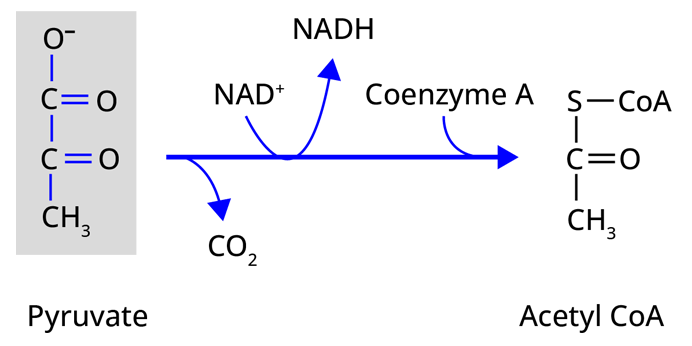
2. What is the function of molecular oxygen in cellular respiration?
It causes the breakdown of citric acid.
To combine with glucose to produce carbon dioxide.
To combine with carbon from organic molecules to produce carbon dioxide.
To combine with hydrogen from organic molecules to produce water.
Ans: d. To combine with hydrogen from organic molecules to produce water
The oxygen obtained from cellular respiration combines with the hydrogen obtained from the oxidation of organic molecules to form water.
3. Excess ATP inhibits the enzyme:
Phosphofructokinase
Hexokinase
Aldolase (Lyase)
Pyruvate decarboxylase
Ans: a. Phosphofructokinase
Phosphofructokinase is an essential glycolysis regulating enzyme. It converts fructose-6-phosphate to fructose-1, 6-bisphosphate by phosphorylating it. It's an allosteric enzyme, which means it works in both directions. This enzyme has a significant allosteric inhibitor in the form of ATP. A high level of ATP implies an energy surplus and the need to stop or slow down glucose lysis. Inhibition of phosphofructokinase, as well as hexokinase and pyruvate kinase, is used to achieve this.
Conclusion
Respiration in plants has many important topics which are repetitively asked in the examination. The summary of the chapter has been made in such a way that the last-minute goes through and can bring clarity to the topics. Also, there are certain sample questions and practice questions added at the end of the chapter. The student must go through them to have an understanding of the type of questions asked in NEET.
NEET Biology Important Chapter- Respiration in Plants

 Share
ShareFAQs on NEET Biology Important Chapter- Respiration in Plants
1. What weightage does the unit Plant Physiology make in NEET?
The unit Plant Physiology makes 13% of the weightage in the NEET exam. This unit carries 5 chapters in total, respiration in plants being one of them.
2. How important is the chapter Respiration in plants as per NEET?
As per NEET, the chapter Respiration in Plants carries moderate importance as only 1-2 questions are asked from this chapter. However, the unit as a whole is important and should be remembered thoroughly.
3. What are some helpful tips for learning the Respiration in Plants Chapter?
To master the chapter 'Respiration in Plants,' the first step is to completely study it from the NCERT. Pursue conceptual comprehension by reasoning through everything you encounter in the chapter. After that, complete all of the NCERT questions and consult the synopsis of the chapter provided on the Vedantu. Before taking the exam, practise all of the diagrams in the chapter and go through it again at least 2-3 times. Also, practice all the practice and sample questions added to the article, so that you can have an understanding of the kind of questions that can appear in the exam.








 Watch Video
Watch Video
